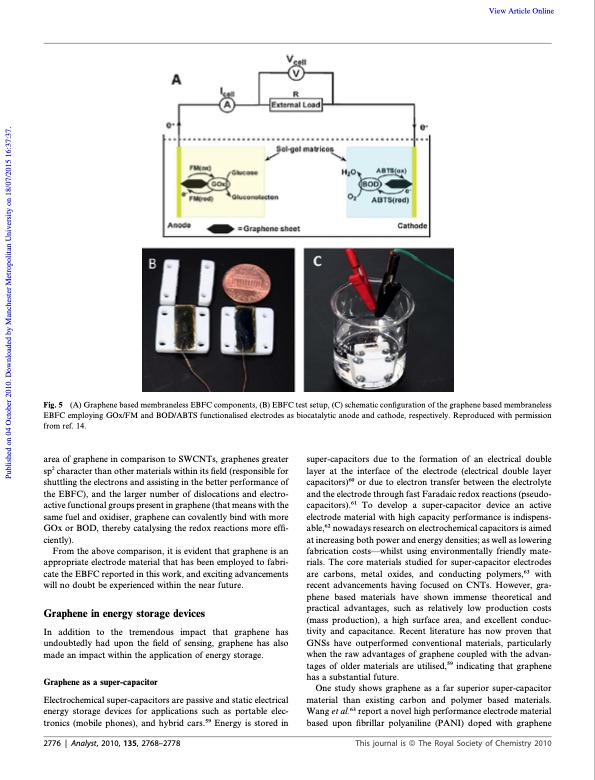PDF Publication Title:
Text from PDF Page: 010
Fig. 5 (A) Graphene based membraneless EBFC components, (B) EBFC test setup, (C) schematic configuration of the graphene based membraneless EBFC employing GOx/FM and BOD/ABTS functionalised electrodes as biocatalytic anode and cathode, respectively. Reproduced with permission from ref. 14. area of graphene in comparison to SWCNTs, graphenes greater sp2 character than other materials within its field (responsible for shuttling the electrons and assisting in the better performance of the EBFC), and the larger number of dislocations and electro- active functional groups present in graphene (that means with the same fuel and oxidiser, graphene can covalently bind with more GOx or BOD, thereby catalysing the redox reactions more effi- ciently). From the above comparison, it is evident that graphene is an appropriate electrode material that has been employed to fabri- cate the EBFC reported in this work, and exciting advancements will no doubt be experienced within the near future. Graphene in energy storage devices In addition to the tremendous impact that graphene has undoubtedly had upon the field of sensing, graphene has also made an impact within the application of energy storage. Graphene as a super-capacitor Electrochemical super-capacitors are passive and static electrical energy storage devices for applications such as portable elec- tronics (mobile phones), and hybrid cars.59 Energy is stored in super-capacitors due to the formation of an electrical double layer at the interface of the electrode (electrical double layer capacitors)60 or due to electron transfer between the electrolyte and the electrode through fast Faradaic redox reactions (pseudo- capacitors).61 To develop a super-capacitor device an active electrode material with high capacity performance is indispens- able,62 nowadays research on electrochemical capacitors is aimed at increasing both power and energy densities; as well as lowering fabrication costs—whilst using environmentally friendly mate- rials. The core materials studied for super-capacitor electrodes are carbons, metal oxides, and conducting polymers,63 with recent advancements having focused on CNTs. However, gra- phene based materials have shown immense theoretical and practical advantages, such as relatively low production costs (mass production), a high surface area, and excellent conduc- tivity and capacitance. Recent literature has now proven that GNSs have outperformed conventional materials, particularly when the raw advantages of graphene coupled with the advan- tages of older materials are utilised,59 indicating that graphene has a substantial future. One study shows graphene as a far superior super-capacitor material than existing carbon and polymer based materials. Wang et al.63 report a novel high performance electrode material based upon fibrillar polyaniline (PANI) doped with graphene 2776 | Analyst, 2010, 135, 2768–2778 This journal is a The Royal Society of Chemistry 2010 View Article Online Published on 04 October 2010. Downloaded by Manchester Metropolitan University on 18/07/2015 16:37:37.PDF Image | Graphene Electrochemistry

PDF Search Title:
Graphene ElectrochemistryOriginal File Name Searched:
c0an00590h.pdfDIY PDF Search: Google It | Yahoo | Bing
Salgenx Redox Flow Battery Technology: Power up your energy storage game with Salgenx Salt Water Battery. With its advanced technology, the flow battery provides reliable, scalable, and sustainable energy storage for utility-scale projects. Upgrade to a Salgenx flow battery today and take control of your energy future.
CONTACT TEL: 608-238-6001 Email: greg@infinityturbine.com (Standard Web Page)